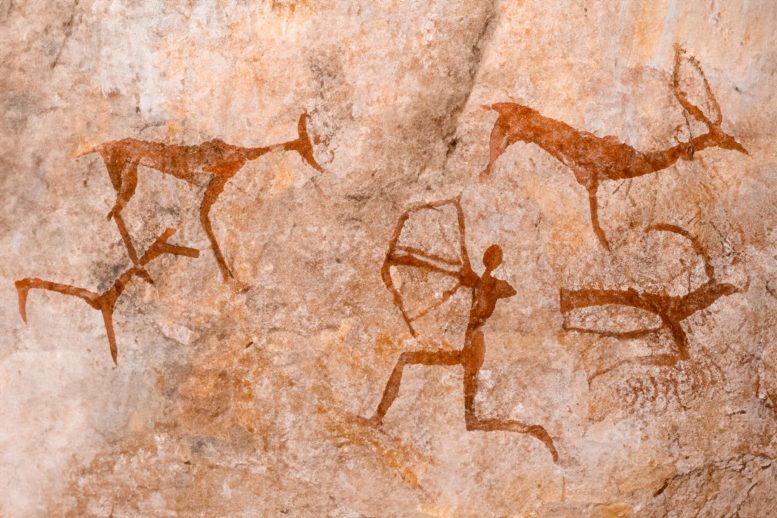
University of Delaware anthropology professor Sarah Lacy has proposed a new theory that challenges the familiar story that labor roles during ancient times were divided by sex and that men evolved to be hunters and women to be gatherers.
Team discovered little evidence to support the idea that roles were assigned specifically to each sex.
It’s a familiar story to many of us: In prehistoric times, men were hunters and women were gatherers. Women were not physically capable of hunting because their anatomy was different from men. And because men were hunters, they drove human evolution.
But that story’s not true, according to research by University of Delaware anthropology professor Sarah Lacy, which was recently published in Scientific American and in two papers in the journal American Anthropologist.
Lacy and her colleague Cara Ocobock from the University of Notre Dame examined the division of labor according to sex during the Paleolithic era, approximately 2.5 million to 12,000 years ago. Through a review of current archaeological evidence and literature, they found little evidence to support the idea that roles were assigned specifically to each sex. The team also looked at female physiology and found that women were not only physically capable of being hunters, but that there is little evidence to support that they were not hunting.
Addressing Gender Bias in Archaeological Findings
Lacy is a biological anthropologist who studies the health of early humans, and Ocobock is a physiologist who makes analogies between modern day and the fossil record. Friends in graduate school, they collaborated after “complaining about a number of papers that had come out that used this default null hypothesis that cavemen had a strong gendered division of labor, the males hunt, females gather things. We were like, ‘Why is that the default? We have so much evidence that that’s not the case,’” Lacy said.
The researchers found examples of equality for both sexes in ancient tools, diet, art, burials, and anatomy.
“People found things in the past and they just automatically gendered them male and didn’t acknowledge the fact that everyone we found in the past has these markers, whether in their bones or in stone tools that are being placed in their burials. We can’t really tell who made what, right? We can’t say, ‘Oh, only males flintknap,’ because there’s no signature left on the stone tool that tells us who made it,” Lacy said, referring to the method by which stone tools were made. “But from what evidence we do have, there appears to be almost no sex differences in roles.”
Physiological and Anatomical Evidence
The team also examined the question of whether anatomical and physiological differences between men and women prevented women from hunting. They found that men have an advantage over women in activities requiring speed and power, such as sprinting and throwing, but that women have an advantage over men in activities requiring endurance, such as running. Both sets of activities were essential to hunting in ancient times.
The team highlighted the role of the hormone estrogen, which is more prominent in women than men, as a key component in conferring that advantage. Estrogen can increase fat metabolism, which gives muscles a longer-lasting energy source and can regulate muscle breakdown, preventing muscles from wearing down. Scientists have traced estrogen receptors, proteins that direct the hormone to the right place in the body, back to 600 million years ago.
“When we take a deeper look at the anatomy and the modern physiology and then actually look at the skeletal remains of ancient people, there’s no difference in trauma patterns between males and females, because they’re doing the same activities,” Lacy said.
Understanding Paleolithic Societies
During the Paleolithic era, most people lived in small groups. To Lacy, the idea that only part of the group would hunt didn’t make sense.
“You live in such a small society. You have to be really, really flexible,” she said. “Everyone has to be able to pick up any role at any time. It just seems like the obvious thing, but people weren’t taking it that way.”
Origin of the Gendered Theory
The theory of men as hunters and women as gatherers first gained notoriety in 1968, when anthropologists Richard B. Lee and Irven DeVore published Man the Hunter, a collection of scholarly papers presented at a symposium in 1966. The authors made the case that hunting advanced human evolution by adding meat to prehistoric diets, contributing to the growth of bigger brains, compared to our primate cousins. The authors assumed all hunters were male.
Lacy points to that gender bias by previous scholars as a reason why the concept became widely accepted in academia, eventually spreading to popular culture. Television cartoons, feature films, museum exhibits, and textbooks reinforced the idea. When female scholars published research to the contrary, their work was largely ignored or devalued.
“There were women who were publishing about this in the ’70s, ’80s and ’90s, but their work kept getting relegated to, ‘Oh, that’s a feminist critique or a feminist approach,’” Lacy said. “This was before any of the work on genetics and a lot of the work on physiology and the role of estrogen had come out. We wanted to both lift back up the arguments that they had already made and add to it all the new stuff.”
Rethinking Prehistoric Gender Roles
Lacy said the “man the hunter” theory continues to influence the discipline. While she acknowledges that much more research needs to be done about the lives of prehistoric people — especially women — she hopes her view that labor was divided among both sexes will become the default approach for research in the future.
For 3 million years, males and females both participated in subsistence gathering for their communities, and dependence on meat and hunting was driven by both sexes, Lacy said.
“It’s not something that only men did and that therefore male behavior drove evolution,” she said. “What we take as de facto gender roles today are not inherent, do not characterize our ancestors. We were a very egalitarian species for millions of years in many ways.”
Reference: “Woman the hunter: The archaeological evidence” by Sarah Lacy and Cara Ocobock, 4 September 2023, American Anthropologist.
DOI: 10.1111/aman.13914









I guess all those “uncontacted” tribes and all the hunter-gatherer pygmies in Africa have it wrong then. Ha…! who knew an American feminist academic would set them right!
I urge readers to examine the actual paper; its evidence has absolutely NOTHING to do with gender specialization prior to the Holocene (the last 12,000 years). It does provide lots of evidence that some women participate in hunting in some modern hunter-gatherer societies — MODERN societies. It also provides evidence of some women engaging in hunting in societies in the last 12,000 years. It does not provide any evidence about gender specialization among hominims prior to the Neolithic period. Despite this complete lack of evidence, the authors mendaciously claim that the modern data proves that there was no gender specialization among mesolithic and paleolithic hunter-gatherer societies.
The authors are also untruthful in claiming that there is no evidence of gender specialization in hunter-gatherer societies prior to the Holocene. There is in fact plenty of evidence to that effect. For example, the fact that males have greater upper-body strength can only be explained by the hypothesis that males engaged exclusively in hunting behavior. (Early hunting was based on rock-throwing.) There is also the fact that males show an intense passion for throwing things — also explainable only by the gender-specialization hypothesis. Males have more sweat glands — again, explainable only by the gender specialization hypothesis. Lastly, there is the simple fact that a hunter-gatherer group’s reproductive capacity was directly proportional to the number of breeding females. This made such females too precious to risk in hunting expeditions. Males were expendable; kill most of the males and the troop can continue to reproduce without loss; kill one breeding female and the troop’s reproductive capacity is diminished.
These are only the most prominent facts that the authors sweep under the rug. Their own hypothesis cannot begin to explain these undeniable facts. Their paper is a political document, not a scientific one; I am surprised that so many journalists are so ignorant of basic facts of human evolution that they publicized this atrocity of a paper.
This myth about “…but that women have an advantage over men in activities requiring endurance, such as running. Both sets of activities were essential to hunting in ancient times.” gets repeated simply too often. You don’t need to theorize when there is actual evidence to the contrary: Just go have a look the the endurance related athletics, etc. records. There is consistent gender gap in males’ favor (e.g. the marathon record time for men is 10% less that of women, even though men have a higher body mass). There is so much agenda and bias masquerading as science here.
Gotta love gender politics infiltrating everything.
No one knows s*** because we were not there. /the end
“Ocobock is a physiologist who makes analogies between modern day and the fossil record” We don’t want analogies, we want actual facts. Stop the madness.
First off, we’ve known this for a while. The article doesn’t even mention the definitive fossil evidence that shows gatherer specific bone scars on finger bones and hunter specific wounds are found regularly on both women and men. The idea that you wouldn’t use all available resources is frankly ridiculous. Hunting is a high energy activity and would require rest days, during which there’s zero reason that person wouldn’t assist with gathering, a low energy activity. But this article isn’t going to change people’s mind, just look at the other comments:
Kelly- If you want facts then you should probably not believe anything anyone says about ancient human civilization. There are no facts, just observations and points of data that help us make educated guesses.
LuckyLuke- Why are you basing your entire opinion on the concept of a marathon, which was only invented in 1896? How about you look at ultra marathons where women are frequently winners and record holders. Your agenda and bias is pretty clear too, if you’re trying to suggest men being 10% better in endurance eliminates women from being part of a hunting party.
Chris Crawford- “males have greater upper-body strength can only be explained by the hypothesis that males engaged exclusively in hunting behavior”, really you’re going to say there’s only one explanation? There couldn’t possibly be some as of yet unknown evidence that contradicts that theory? You seem to be more confident about that statement than anthropologists and archaeologists with PHDs… And that’s not even touching your ridiculous assertion that men were expendable while women were invaluable. Oh, women can just pop out a new baby to replace lost men? Do you think babies were capable of hunting straight out of the womb? Babies take a lot of effort/resources to nurture and you only have a 50% chance of even having a male, even less odds of that male child surviving to an age that they would be able to hunt. Every human life was invaluable. The idea that men were disposable is idiotic.
Something I think that you overlook is that trying to stalk an animal to get close enough to spear or shoot it with an arrow becomes problematic if a female hunter has a suckling child and has to take time to feed it. A common behavior of a hungry child is to cry. Imagine just getting ready to attack a gazelle, and the child starts crying. It will not only get the attention of the gazelle, but the sound will probably attract top predators like lions as effectively as modern predator calls attract coyotes and bobcats. Tracking a wounded herbivore, while simultaneously being tracked by a potentially deadly predator is not advised for longevity, especially if one’s only spear is lodged in the prey. Once an animal is wounded, it may not die immediately (even with a bullet), and may require being tracked for hours to as much as two or three days, all the while caring for a small child. When a female does not have a suckling child, she will have monthly periods, and the dripping blood will be like a Hansel and Gretel cookie crumb trail to predators.
Now here’s the really important part. In order to be useful to the tribe, the hunter must return some significant weight of meet to the tribe’s camp. The stronger the hunter, the more meat they can carry. A suckling child cannot run as fast as the adult, so she would have to both carry the child and the meat, in an attempt to get the meat back to the tribe before it spoils in the heat. A male hunter would have none of those impediments. Male hunters could track and kill every day that they are not sick or injured, which would also limit women. Gender specialization has advantages for a tribe, whether it be in hunting or warfare.
“the definitive fossil evidence that shows gatherer specific bone scars on finger bones and hunter specific wounds are found regularly on both women and men.”
I would certainly like to see that evidence, as I cannot imagine how one might differentiate between bone scars caused by fighting prey animals and bone scars cause by predatory animals.
“The idea that you wouldn’t use all available resources is frankly ridiculous.”
No, what is ridiculous is exposing your most important resource — reproductive capacity — to the most dangerous activities. Troops that engaged in such behavior would have been unable to maintain their population.
“Hunting is a high energy activity and would require rest days…”
No, what we have inferred about early hominim hunting practices is that they involved lots of walking in the hot sun — definitely NOT a high-energy activity.
“But this article isn’t going to change people’s mind…”
That’s certainly true of those whose purpose is political rather than scientific. I agree that some of the commentators here appear to have political agendas — but an honest person must admit that the authors of the paper have their own political agenda. I myself am always happy to alter my assessments in response to new information.
“How about you look at ultra marathons where women are frequently winners and record holders. ”
This surprised me, so I dug into it. Here’s a relevant quote: “Overall, the study found that female ultra runners are faster than their male counterparts for distances longer than 195 miles (314km).” Source: https://www.fitnessfirst.com.au/get-there/new-study-finds-women-are-better-at/
This information, while surprising, is irrelevant to the question of hunting practices in hominims, who did not run for 37 hours during a hunt. The most common hunting practice in East Africa entailed miles of walking in the hot sun — not running. Minimizing water expenditure was crucial to success.
“really you’re going to say there’s only one explanation?”
If you have a better explanation, let’s hear it. So far, the hypothesis of gender specialization in hominims explains many such phenomena far better than any other hypothesis. Yes, it’s a hypothesis, not a proven fact — EVERYTHING in science is a hypothesis! Only in mathematics do we enjoy the capacity for proof.
“You seem to be more confident about that statement than anthropologists and archaeologists with PHDs”
Please provide the names of anthropologists and archaeologists who explicitly reject the gender-specialization hypothesis in favor of some unknown hypothesis.
” The idea that men were disposable is idiotic.”
You appear to be unaware of some basic facts of human reproduction. The process of impregnating a female requires only a few minutes of effort, while the process of bringing the resulting fetus to term requires nine months. Thus, a troop with one male and ten females can reproduce as rapidly as a troop with ten males and ten females — although the genetic health of the resulting children will be somewhat less with only one man. By contrast, a troop with ten males and one female can reproduce at only one-tenth the rate of the first two groups. At normal mortality rates, it will be unable to maintain its population and will be forced to dissolve into its parent clan. Remember, hominim populations were living close to the edge of extinction — one study shows that hominims went through a population bottleneck during early Paleolithic times. Maintaining a high birth rate was crucial to survival, and risking the lives of females was foolish.
By the way, this truth has long been recognized by human cultures. It is a near-universal societal behavior to capture women but kill men.
Clyde, a few corrections. First, for most of the evolutionary history of hominims, only rocks were used as projectiles. Spears and arrows were rather late to appear. The oldest spear is a wooden spear, rather flimsy, that’s about 400,000 years old. It wasn’t particularly effective because, first, it wasn’t straight enough to be thrown, and second, it was too light to have much penetrating power. The best guess is that it was used to finish off rather thin-skinned prey that had already been brought down. The earliest arrows show up about 70,000 years ago.
The basic hunting strategy in East Africa was based on heat exhaustion. First, you waited until about noon to begin your hunt. You crept up to your prey, then leapt up and hurled rocks at it. You’d probably miss, and the animal would take off, easily outrunning you. No problem; you patiently pursued it at a comfortable walking pace. It would run for a few hundred meters, then stop to cool off and resume eating. You creep up on it again and again leap up and throw rocks. Again it runs. You continue this process for several hours in the afternoon heat. The animal starts getting hot from all the running. You, however, have more sweat glands to keep you cool, and you expend little energy walking in pursuit, so you remain cool. Eventually, the animal is so hot that it doesn’t run as far, meaning that you get to make him run more often. Eventually, heat exhaustion overcomes the animal, and you close in as it lies panting on the ground, and finish it.
This system is a sure winner, but the ability to throw rocks powerfully and accurately is crucial to success. If you can hit the prey with a fast rock, that will slow it down and speed up the hunt. That’s why hominim males developed excellent rock-throwing abilities; no creature on the planet can match our skills at rock-throwing. That’s why hominim males have so much chest musculature. That’s why our image of a highly masculine guy always shows him with gigantic chest and upper arm musculature. That’s why little boys are always throwing rocks at things. And I’m sure that you’ve heard the insult “He throws like a girl!”
You’re dead right about the overwhelming difficulties that females would have on the hunt. However, most hunter-gatherer societies developed communal breast-feeding systems. One lactating female would remain at camp and feed the young while the other active females went out gathering. They invented day care — what a concept! We seem to have forgotten much of it.
However, the system has its flaws: conflicts between females might induce the wet nurse to underfeed her rival’s kids, triggering nasty conflicts. Presumably the elders kept an eye out for this kind of misbehavior, and by hurrying back to camp often, a suspicious mother could insure that her kids were adequately fed. Nevertheless, this did reduce the efficiency of the system.
Here are a few cute details: hunting required the ability to estimate the target prey’s path over broken ground, which required sophisticated spatial reasoning. Sure enough, modern tests demonstrate that males have stronger spatial reasoning than females. (Females have superior social reasoning skills.)
An even cuter detail comes from an English study some years ago. There was some sort of street food fair in the suburbs of London. It was organized as a series of stalls offering different products along a path wending through a big rectangle. The researchers set up at the exit of the fair and accosted couples emerging from the fair. They separated the couple and gave each one a map of the stalls, then challenged each person to identify the locations of specific stalls. (e.g., “Mark down where they were selling pickles. Mark down where they were selling tomatoes.” etc.) The women did MUCH better than the men. Memorizing the locations of specific sources of food is a crucial skill for gatherers, and of little value to hunters.
“The basic hunting strategy in East Africa was based on heat exhaustion.”
And the technique is still used by some hunter gatherer tribes except that arrows with a weak poison are used to insure that the prey eventually dies.
“One lactating female would remain at camp and feed the young while the other active females went out gathering.”
The obvious question is, “How many children could a surrogate handle?” Obviously, a woman can handle up to two simultaneously. However, the actual limitation is how quickly a surrogate can replenish her milk, which might be limited by the availability of water. Personally, I doubt that a surrogate could handle more than two or three effectively. That means only about half the women with children would be relieved of feeding any one day. A better solution, which seems to have been universal in at least North America, is the invention of the papoose board to allow a woman to travel with her child on her back. Even Inuit women resorted to carrying their children under their parka. It is difficult to believe that other cultures didn’t similarly see the connection between the need to frequently feed their babies and the ability to carry things on their backs, leaving their hands free to gather things. Gathering or hunting small game (using rocks or throwing sticks) between feedings increases the efficiency of the activity instead of taking half the women out of the activity.
Excellent points, Clyde. Thanks for the information.
McSlooter, First, my comment was specifically regarding the unevidenced assertion in the article/interview about inferiority of human males in realistic endurance settings (that’s why I cited the records for Marathon which is a good upper bound for realistic scenarios).
Second you assertion regarding “ultra-marathon” is simply more of the unevidenced fake “facts” that gets repeated and goes unchallenged, too often. Here is more simple statistics: https://en.wikipedia.org/wiki/Ultramarathon#IAU_World_Record_performances. Taking 5 minutes to google something once in a while and reading others’ comments more carefully, before lecturing everyone, does not that hurt, you know.
More feminist tripe.
LuckyLuke, thanks for providing that link. It demolishes McSlooter’s claim regarding female endurance, which I accepted too readily.
ma willy hords……………………